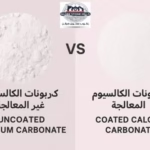Calcium Carbonate vs Talc : A Comparison of Industrial Applications
Both calcium carbonate and talc are natural minerals with physical and chemical properties that make them valuable in many industries and applications. Despite their different chemical compositions and some properties, they share many uses, which raises questions about the relationship between them.
For more details about talc and its uses in various industries, you can read the following article: Talc | History, Uses & Facts
.
Similarities and differences between calcium carbonate and talc
| Aspect | Calcium Carbonate | Talc |
|---|---|---|
| Filler Material | Widely used as a filler in industries like paper, paints, and plastics. | Used as a filler in paper, cosmetics, and paints. |
| Paint Pigment | Often used as a white pigment or base for mixing other colors. | Used as a white pigment or base for other color mixes. |
| Absorbent Material | Has low absorbent properties compared to Talc. | Known for its excellent absorption of moisture and oils. |
| Carrier for Active Ingredients | Used as a carrier in pharmaceuticals and cosmetics. | Also used as a carrier for active ingredients in pharmaceuticals and cosmetics. |
| Chemical Properties | Composed of Calcium Carbonate (CaCO₃). | Composed of Talc (Mg₃Si₄O₁₀(OH)₂). |
| Industrial Applications | Commonly used in cement, construction, and manufacturing. | Mainly used in high-quality paper production and cosmetics. |
Factors affecting the choice of material
When choosing either calcium carbonate or talc for a particular use, the following factors should be considered:
- Required properties of the final product: Does the product need a filler with high absorption capacity? Should the surface be smooth?
- Cost: Both materials come in different prices, so budget should be taken into consideration.
- Environmental and health effects: The environmental and health effects of both substances must be evaluated before they are used.
Although there is some overlap in the uses of calcium carbonate and talc, each has unique properties that make it suitable for specific applications. Choosing the right material depends on the desired properties of the final product.
About the largest company in grinding and producing calcium carbonate Globe Stone Hills
Recent Posts
- Calcium Carbonate Quarries in Egypt | High-Purity White Mineral for Industries
- Difference Between Coated and Uncoated Calcium Carbonate
- The Role of Calcium Carbonate in the Pharmaceutical Industry
- The Use of Calcium Carbonate in Pavement Construction
- Calcium Carbonate vs Talc : A Comparison of Industrial Applications
Categories
Latest Posts
Contact the Globe Stone Hills team
Gallery
- © Copyright 2024. Globe Stone Hills




















